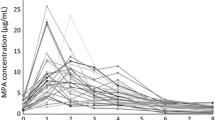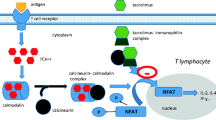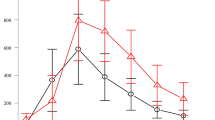Abstract
Background Cyclosporin is a calcineurin inhibitor widely used in renal transplant patients to prevent organ rejection. Several position papers have been published but no reports on the practical experience in pediatric patients undergoing conversion between cyclosporin innovator and generic products are available. Objective To evaluate the pharmacokinetics and safety as part of therapeutic monitoring of cyclosporin in renal transplant pediatric patients who switch from the innovator to the generic formulation in Argentina. Setting Hospital de Pediatría JP Garrahan, Buenos Aires, Argentina. Methods Stable pediatric renal transplant patients (6 months post-transplant) switched from the innovator to the generic formulation of cyclosporin microemulsion capsule. Cyclosporin pharmacokinetic parameters were obtained while taking the innovator and after starting with the generic formulation. Blood samples were drawn before and 1, 2, and 3 h after drug administration and subsequently quantified. Pharmacokinetic parameters were obtained by means of a Bayesian approach. Main outcomes measure Cyclosporin pharmacokinetic parameters (area under the curve, AUC; Blood concentration after 2 h, C2), adverse events and graft rejection. Results A total of 12 patients were included. Median (range) age and time post-transplant were 10.7 years (6.5–17.7) and 8.3 years (3.4–14.0), respectively. Two patients or their parents did not consent to the switch. Median (range) dose normalized cyclosporin AUC and C2 were 1.15 (mg*h/L)/mg/kg (0.72–3.0) and 265.5 (ng/ml)/mg/kg (120.8–725.7), respectively, on the innovator therapy and 1.05 (mg*h/L)/mg/kg (0.54–2.22) and 317.1 (ng/ml)/mg/kg (116.7–564.7) for the generic drug after the switch. The median (range) percentage of change in the AUC and C2 when switching between formulations were 16.7 % (0.7–56.7) and 13.1 % (3.7–68.6), respectively. No significant changes in serum creatinine levels were registered when comparing before and after substitution of products. Adverse events (number of events) recorded 5 months before and after the switch included hirsutism (2), hypertension (2), and gingival hyperplasia (1). Conclusion Conversion of cyclosporin from innovator brand to generic in pediatric renal transplant patients needs to be closely monitored.
Similar content being viewed by others
References
Nashan B, Cole E, Levy G, Thervet E. Clinical validation studies of Neoral C(2) monitoring: a review. Transplantation. 2002;73:S3–11.
Halloran P. Immunosuppressive drugs for kidney transplantation. N Engl J Med. 2004;351:2715–29.
Eljebari H, Ben Fradj N, Salouage I, Gaies E, Trabelsi S, Jebabli N, et al. Estimation of abbreviated cyclosporine A area under the concentration-time curve in allogenic stem cell transplantation after oral administration. J Transplant. 2012; 2012:342701.
Tönshoff B, Höcker B. Treatment strategies in pediatric solid organ transplant recipients with calcineurin inhibitor-induced nephrotoxicity. Pediatr Transplant. 2006;10(6):721–9.
Pollock-Barziv SM, Finkelstein Y, Manlhiot C, Dipchand AI, Hebert D, Ng VL, et al. Variability in tacrolimus blood levels increases the risk of late rejection and graft loss after solid organ transplantation in older children. Pediatr Transplant. 2010;14(8):968–75.
Margreiter R. European tacrolimus vs ciclosporin microemulsion renal transplantation study group efficacy and safety of tacrolimus compared with ciclosporin microemulsion in renal transplantation: a randomised multicentre study. Lancet. 2002;359(9308):741–6.
Riva N, Cáceres Guido P, Rousseau M, Dip M, Monteverde M, Imventarza O, et al. Pharmacovigilance of calcineurin inhibitor in peidatric kidney and liver transplantation. Farm Hosp. 2013;37(6):441–9.
Henry ML. Cyclosporine and tacrolimus (FK506): a comparison of efficacy and safety profiles. Clin Transplant. 1999;13(3):209–20.
Sy SK, Heuberger J, Shilbayeh S, Conrado DJ, Derendorf H. A Markov chain model to evaluate the effect of CYP3A5 and ABCB1 polymorphisms on adverse events associated with tacrolimus in pediatric renal transplantation. AAPS J. 2013;15(4):1189–99.
Singh AK, Narsipur SS. Cyclosporine: a commentary on brand versus generic formulation exchange. J Transplant. 2011;2011:480642.
Cattaneo D, Perico N, Remuzzi G. Generic cyclosporine formulations: more open questions than answers. Transpl Int. 2005;18(4):371–8.
Harrison JJ, Schiff JR, Coursol CJ, Daley CJ, Dipchand AI, Heywood NM, et al. Generic immunosuppression in solid organ transplantation: a Canadian perspective. Transplantation. 2012;93(7):657–65.
Van Gelder T. European Society for Organ Transplantation Advisory Committee recommendations on generic substitution of immunosuppressive drugs. Transpl Int. 2011;24(12):1135–41.
Latran M. Response to Klintmalm on the use of generic immunosuppression. Am J Transplant. 2012;12(3):791.
Marquet P. Counterpoint: Is pharmacokinetic or pharmacodynamic monitoring of calcineurin inhibition therapy necessary? Clin Chem. 2010;56(5):736–9.
Irtan S, Saint-Marcoux F, Rousseau A, Zhang D, Leroy V, Marquet P, et al. Population pharmacokinetics and bayesian estimator of cyclosporine in pediatric renal transplant patients. Ther Drug Monit. 2007;29(1):96–102.
Troncoso P, Ortiz AM, Jara A, Vilches S. Abbreviated AUC monitoring of cyclosporine more adequately identified patients at risk for acute rejection during induction of immunosuppressive therapy after kidney transplantation than recommended C2 concentration values. Transplant Proc. 2009;41(1):127–30.
Mahalati K, Belitsky P, West K, Kiberd B, Fraser A, Sketris I, et al. Approaching the therapeutic window for cyclosporine in kidney transplantation: a prospective study. J Am Soc Nephrol. 2001;12(4):828–33.
NEORAL® Soft Gelatin Capsules (cyclosporine capsules, USP) MODIFIED and NEORAL® Oral Solution (cyclosporine oral solution, USP) MODIFIED. Prescribing Information. NOVARTIS. Reference ID: 3302945. Available from: http://www.accessdata.fda.gov/drugsatfda_docs/label/2013/050715s033,050716s034lbl.pdf. Accessed 10 Feb 2014.
Certificados de especialidades medicinales emitidos - Monofármacos - Junio 2007. ANMAT. Available from: http://www.anmat.gov.ar/ESPECMED/junio/certificados_monofarmacos_07.asp. Accessed 11 Feb 2014.
Drugs and money—prices, affordability and cost containment. In: Dukes M, Haaijer-Ruskamp F, de Joncheere C, Rietveld A, editors. World Health Organization. Regional Office for Europe by IOS Press; 2003. pp. 137–149. ISBN 1 58603 334 4.
Kaplan WA, Wirtz VJ, Stephens P. The market dynamics of generic medicines in the private sector of 19 low and middle income countries between 2001 and 2011: a descriptive time series analysis. PLoS ONE. 2013;8(9):e74399.
Spence M, Nguyen L, Hui R, Chan J. Evaluation of clinical and safety outcomes associated with conversion from brand name to generic tacrolimus in transplant recipients enrolled in an integrated health care system. Pharmacotherapy. 2012;32(11):981–7.
Alloway RR, Sadaka B, Trofe-Clark J, Wiland A, Bloom RD. A randomized pharmacokinetic study of generic tacrolimus versus reference tacrolimus in kidney transplant recipients. Am J Transplant. 2012;12(10):2825–31.
Kraeuter M, Helmschrott M, Erbel C, Gleissner CA, Frankenstein L, Schmack B, et al. Conversion to generic cyclosporine A in stable chronic patients after heart transplantation. Drug Des Devel Ther. 2013;7:1421–6.
Vítko S, Ferkl M. Interchangeability of ciclosporin formulations in stable adult renal transplant recipients: comparison of Equoral and Neoral capsules in an international, multicenter, randomized, open-label trial. Kidney Int Suppl. 2010;115:S12–6.
Niemczyk M, Paczek L. Generic formulation of Cyclosporine A, Equoral®, in de novo kidney transplant recipients: five-year follow-up. Ann Transplant. 2011;16(2):59–62.
Al Wakeel J, Shaheen FA, Al Alfi A, Abbas Fagir EH, Iman A, Nampoory MR, et al. Cyclosporine microemulsion formulation (sigmasporin microral) effect as first-line immunosuppressant on renal functions at 3 years. Transplant Proc. 2012;44(1):94–100.
Johnston A, Belitsky P, Frei U, Horvath J, Hoyer P, Helderman JH, et al. Potential clinical implications of substitution of generic cyclosporine formulations for cyclosporine microemulsion (Neoral) in transplant recipients. Eur J Clin Pharmacol. 2004;60(6):389–95.
Dunn J, Golden D, Van Buren CT, Lewis RM, Lawen J, Kahan BD. Causes of graft loss beyond two years in the cyclosporine era. Transplantation. 1990;49(2):349–53.
Schiff J, Cole E, Cantarovich M. Therapeutic monitoring of calcineurin inhibitors for the nephrologist. Clin J Am Soc Nephrol. 2007;2(2):374–84.
Levy G, Thervet E, Lake J, Uchida K. On behalf of the CONCERT group: patient management by Neoral C2 monitoring—an international consensus statement. Transplantation. 2002;73:S12–8.
Ng VL, Alonso EM, Bucuvalas JC, Cohen G, Limbers CA, Varni JW, et al. Health status of children alive 10 years after pediatric liver transplantation performed in the US and Canada: report of the studies of pediatric liver transplantation experience. J Pediatr. 2012;160(5):820–6.
Filler G. Calcineurin inhibitors in pediatric renal transplant recipients. Paediatr Drugs. 2007;9(3):165–74.
Miranda I, Cherato M, Onofri A. Cobertura social para trasplantados subsidados por CUCAIBA en la red estatal. Available from: http://www.cucaiba.gba.gov.ar/019.htm. Accessed 12 Feb 2014.
Calabria A. Analyzing the market for organs donation: evaluation of the introduction of incentives in Argentina. MPRA Paper No. 36044. 2011. Available from: http://mpra.ub.uni-muenchen.de/36044/1/MPRA_paper_36044.pdf. Accessed 12 Feb 2014.
Petan JA, Undre N, First MR, Saito K, Ohara T, Iwabe O, et al. Physiochemical properties of generic formulations of tacrolimus in Mexico. Transplant Proc. 2008;40(5):1439–42.
Drug interactions. Micromedex Solutions. Available from: http://www.micromedexsolutions.com/micromedex2/librarian/PFDefaultActionId/evidencexpert.ShowDrugInteractionsResults. Accessed 14 Feb 2014.
Acknowledgments
The authors would like to thank Dr. Pierre Marquet for the web service offered by the University of Limoges for pharmacokinetic assessment of immunosuppressants and head nurse Victoria Barroca, for technical assistance.
Funding
This work was supported by Hospital de Pediatría Prof. Dr. Juan P. Garrahan.
Conflicts of interest
None of the authors present conflict of interest.
Author information
Authors and Affiliations
Corresponding author
Rights and permissions
About this article
Cite this article
Riva, N., Guido, P.C., Ibañez, J. et al. Therapeutic monitoring of pediatric renal transplant patients with conversion to generic cyclosporin. Int J Clin Pharm 36, 779–786 (2014). https://doi.org/10.1007/s11096-014-9959-0
Received:
Accepted:
Published:
Issue Date:
DOI: https://doi.org/10.1007/s11096-014-9959-0




